We’re all the time informed that having a low A1c is a vital objective in our diabetes administration, however have you learnt why? Are you aware what a great A1c goal is, tips on how to decrease your A1c, and the way shortly you may decrease your A1c safely?
These are the questions I’ll reply on this complete information on what A1c is, tips on how to decrease your A1c, and why attaining a low A1c isn’t the one (or essentially the very best) objective relating to diabetes administration.
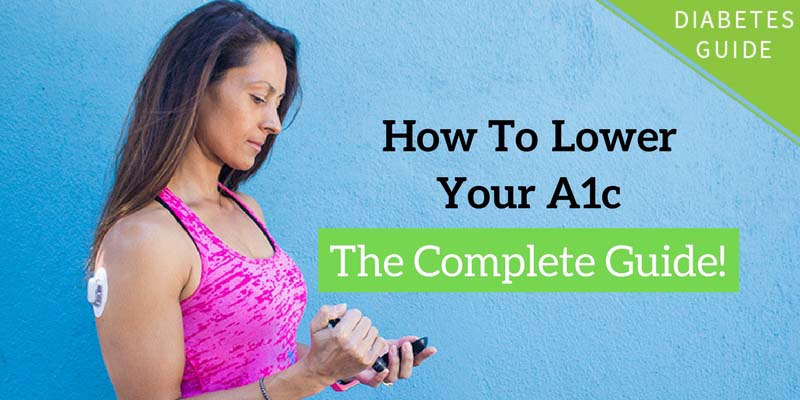
What’s A1c?
A1c, hemoglobin A1c, HbA1c or glycohemoglobin take a look at (all totally different names for a similar factor) is a blood take a look at that measures your common blood sugar over the past 2-3 months. It’s not an “even common,” however a mean the place your blood sugars over the previous couple of weeks rely a bit of greater than your blood sugars 2-3 months in the past.
Based on the Nationwide Institute of Diabetes & Digestive & Kidney Illnesses:
“The A1c take a look at relies on the attachment of glucose to hemoglobin, the protein in pink blood cells that carries oxygen. Within the physique, pink blood cells are continuously forming and dying, however usually they reside for about three months. Thus, the A1c take a look at displays the common of an individual’s blood glucose ranges over the previous three months. The A1c take a look at result’s reported as a proportion. The upper the share, the upper an individual’s blood glucose ranges have been. A traditional A1c stage is beneath 5.7 %.”
It’s necessary to notice right here that the time period “regular A1c stage” on this context refers to individuals with out diabetes. I’ll get again to what a “regular A1c stage” is for individuals dwelling with diabetes beneath.
The way to take a look at your A1c
Your physician or endocrinologist ought to take a look at your A1c repeatedly (usually each 3-6 months). The physician merely pricks your finger (or ear when you desire) and takes a tiny blood pattern. If the physician’s workplace has an A1c equipment, it is best to get your outcome earlier than your session is over.
You can too purchase dwelling A1c kits (no prescription required) and do the take a look at your self. Dwelling A1c kits could be helpful when you go for greater than three months between physician visits and wish to control how your A1c is growing your self.
The house kits are usually correct inside plus/minus 0.5 proportion factors, which is greater than adequate to present you a reliable outcome. The draw back of the house kits is that they require a bigger quantity of blood (4 giant drops) than a daily blood sugar take a look at, and when you don’t apply sufficient blood, you’ll get an error message and could have misplaced a take a look at strip.
You could find dwelling take a look at kits on Amazon and in some pharmacies.
Why it is best to care about your A1c
A number of research have proven that top common blood sugars improve the danger of diabetes-related issues. Decreasing your A1c to the advisable vary will scale back the danger of diabetes-related issues considerably:
- Eye illness danger is decreased by 76%
- Kidney illness danger is decreased by 50%
- Nerve illness danger is decreased by 60%
- Any heart problems occasion danger is decreased by 42%
- Nonfatal coronary heart assault, stroke, or danger of demise from cardiovascular causes is decreased by 57%
Reaching an A1c within the advisable vary is, due to this fact, one of the vital necessary issues you are able to do to enhance your long-term well being while you reside with diabetes.
Nevertheless, the nearer you get to the advisable A1c goal, the much less profit you’re going to get from reducing your A1c additional. Taking your A1c from 12% to 11% makes an enormous distinction whereas reducing your A1c from 7% to six% offers a a lot smaller profit. Actually, reducing your A1c an excessive amount of is probably not a good suggestion if it signifies that you improve how typically you expertise hypoglycemia (low blood sugar).
I’ll clarify why “time-in-range” is simply as necessary as a low A1c later on this information.
What’s a “regular” A1c?
Now that you’ve got your A1c quantity, let’s take a look at what that quantity truly tells you. The American Diabetes Affiliation has established the next tips:
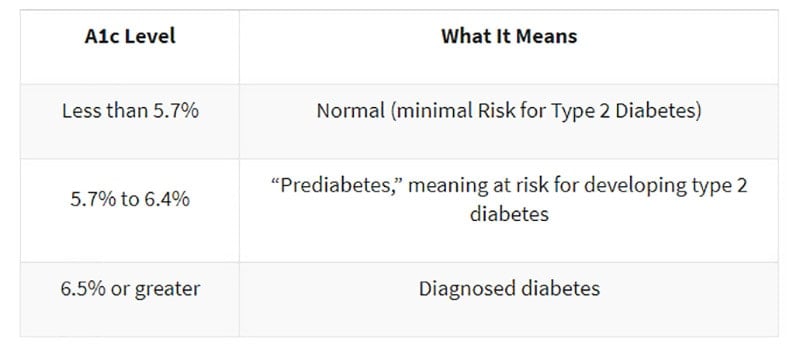
This does NOT imply that you simply want an A1c of lower than 5.7% when you’re dwelling with diabetes. It signifies that when you do NOT reside with diabetes, your A1c is predicted to be beneath 5.7%. There are totally different suggestions for what an acceptable A1c is for individuals dwelling with diabetes.
I had an opportunity to requested Dr. Anne Peters, MD, Director, USC Scientific Diabetes Program and Professor of Scientific Medication Keck College of Medication of USC in addition to Gary Scheiner, MS, CDE, proprietor and Scientific Director of Built-in Diabetes Providers and creator of Assume Like a Pancreas, what their views are on a great A1c goal:
Dr. Peters:
“The A1c goal needs to be no matter is greatest given the particular person’s scientific state of affairs. For athletes, too many lows can restrict efficiency, for somebody who’s pregnant it needs to be <6%, for an older particular person the goal needs to be increased. I usually assume an A1c goal of 6.0 – 7.0% is good and knowledge reveals that going beneath 7% has pretty little influence on issues. Principally, I’d reasonably see somebody with an A1c of 6.9% and low blood sugar variability than an A1c of 6.2% with plenty of variability”
Gary Scheiner, MS, CDE:
“A1c targets needs to be individualized primarily based on the person capabilities, dangers, and prior experiences. For instance, we usually goal for very tight A1c ranges throughout being pregnant and extra conservative targets in younger youngsters and the aged. Somebody with important hypoglycemia unawareness and a historical past of extreme lows ought to goal the next A1c than somebody who can detect and handle their lows extra successfully. And definitely, somebody who has been operating A1c’s in double digits for fairly a while shouldn’t be concentrating on an A1c of 6%… higher to set modest, lifelike, achievable targets.”
Of their Requirements of Medical Care in Diabetes, the American Diabetes Affiliation recommends an A1c goal of beneath 7% for adults dwelling with diabetes. An A1c of seven% roughly interprets to a mean blood sugar of 154 mg/dl (8.6 mmol/L) as you may see from this conversion chart.
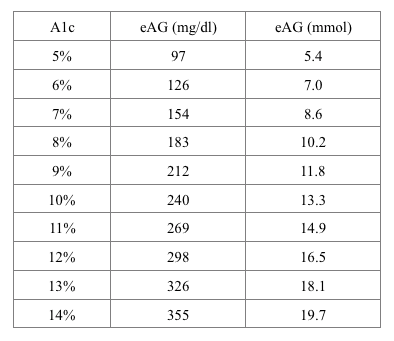
To study extra about blood sugar ranges, please learn “What are Regular Blood Sugar Ranges“.
A1c vs. Time-in-Vary
A1c has lengthy been thought of the very best measure of diabetes administration as a result of it was probably the most correct instrument to look at long-term blood sugar developments. This has modified with the introduction of Steady Glucose Monitoring (CGM). By utilizing a CGM, now you can get a really correct image of not solely your common blood sugar, however your blood sugar fluctuations as nicely.
This makes it attainable to trace one other key part of diabetes administration: Time-in-Vary.
Time-in-range refers back to the proportion of time by which your blood sugar is inside a selected vary. To see why time-in-range is necessary, check out the three traces within the graph beneath. All three traces present a mean blood sugar of about 154 mg/dl (which equals an A1c of about 7%) however with very totally different fluctuations. I believe we’d all desire our blood sugar to comply with line 3 reasonably than line 1.
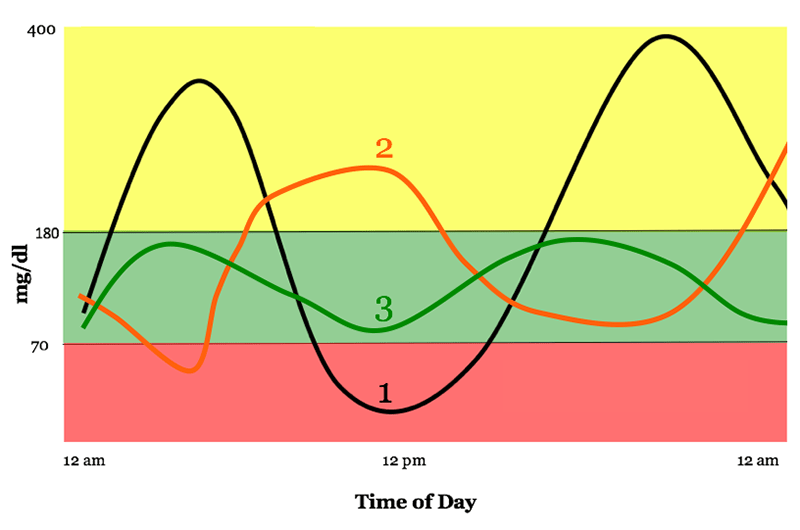
Graph used with permission from Diatribe
Some tips state that your blood sugar vary needs to be set to 70-180 mg/dl (3.9-10 mmol/l), however you could discover that to be too giant or small of a variety for you. Based on this interview with a number of diabetes specialists, most advocate that you simply spend lower than 3% of the time beneath 70 mg/dl (3.9 mmol/l) and fewer than 1% of the time beneath 53 mg/dl (3 mmol/l). Nevertheless, additionally they agree that the precise time spent in vary must be individualized.
On common, the specialists didn’t anticipate the overall diabetes inhabitants to be in vary greater than 50% of the time at most, so speaking about incremental enchancment in all probability makes extra sense than setting a hard and fast quantity.
The way to measure Time-in-Vary
For those who put on a Steady Glucose Monitor (CGM), your time-in-range needs to be listed while you obtain your knowledge (as within the instance from a Dexcom CGM beneath). For those who don’t use a CGM, all you are able to do is take a look at your handbook blood sugar assessments and take note of your quantity of excessive and low blood sugars. What’s an appropriate excessive and low is one thing it’s important to talk about along with your medical group.
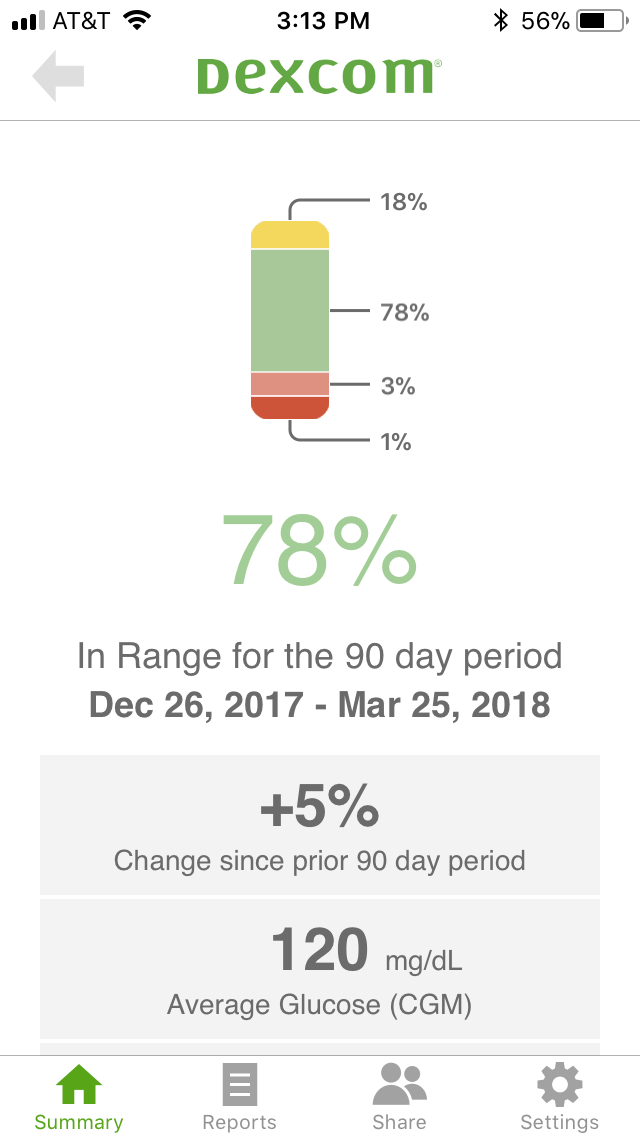
What’s extra necessary: a low A1c or a excessive Time-in-Vary?
Optimally, you’d have an A1c beneath 7% accompanied by a low blood sugar variance (excessive time-in-range). An excellent basic guideline is:
- The upper your A1c, the extra necessary it’s to give attention to getting it down.
- The decrease your A1c, the extra necessary time-in-range turns into.
In case your A1c is beneath 6-7%, specializing in growing your time-in-range will in all probability have a bigger constructive well being influence than reducing your A1c additional.
So is A1c a foul approach to gauge whether or not your diabetes administration is on monitor? Not essentially, however to cite Gary Scheiner, MS, CDE:
“I’ve by no means been an enormous fan of utilizing A1c to gauge the “high quality” of an individual’s glucose management, just because it represents a mean… and a mean can replicate plenty of highs and lows reasonably than time spent inside one’s goal vary. Nevertheless, it’s not one thing we will ignore both since there’s a correlation between A1c and the danger of long-term issues.”
Can your A1c be too low?
As described above, the reply to this query relies upon nearly solely on how typically you expertise hypoglycemia (low blood sugar). For those who (nearly) by no means expertise hypoglycemia, your A1c technically can’t be too low. Some individuals obtain A1c ranges beneath 5% by following a really strict diabetes administration and weight loss program routine and have nearly no blood sugar fluctuations.
HOWEVER, when you typically expertise hypoglycemia, that can end in an “synthetic” low A1c studying as a result of your hypoglycemia occasions are reducing your blood sugar common. In that case, specializing in growing time-in-range is far more necessary than additional reducing your A1c. Actually, you could even profit from a barely increased A1c with fewer blood sugar fluctuations.
It’s additionally necessary to notice that reducing your A1c beneath the advisable vary of 6-7% hasn’t been confirmed to offer any well being advantages. Due to this fact, a really low A1c shouldn’t be a objective in itself.
The way to decrease your A1c
Now that you’ve got a radical understanding of A1c and time-in-range, in addition to why taking a look at your A1c in isolation isn’t optimum, the plain query is:
How do you decrease your A1c whereas enhancing or sustaining your time-in-range?
I’ll cowl the 4 most necessary issues you are able to do beneath nevertheless it’s all the time advisable that you simply begin by having a dialog along with your medical group earlier than making modifications to your diabetes administration.
Establish the principle “ache factors”
Whether or not you might be self-managing your diabetes or work carefully along with your medical group, step one ought to all the time be to attempt to determine the principle “ache factors” or the reason why your A1c is increased than you’d like. The one possible way of doing that is by monitoring your blood sugars very carefully.
For those who put on a Steady Glucose Monitor, you may take a look at your 7-day, 30-day, and 90-day knowledge to see when you can spot any developments. For instance, you may discover that you’re operating excessive from 1-5 AM each night time, each morning (howdy Daybreak Phenomenon) or day by day after meals. Or maybe you all the time go low after train. All of us have totally different blood sugar patterns.
It’s additionally very attainable that you just are operating your blood sugar a bit of too excessive on a regular basis and may benefit from adjusting your diabetes medicine. Figuring out patterns like that makes it attainable to pinpoint areas of potential enchancment so you can begin making a plan for tips on how to restrict your excessive and low blood sugars.
For those who depend on handbook blood sugar testing, it’s a bit of trickier since most individuals don’t take a look at each 5 minutes. What I might advocate is growing how typically you take a look at for some time, and perhaps even take a look at through the night time when you get up anyway. Most meters let you obtain knowledge to your pc, or you may add the information to app-based platforms like One Drop or mySugr. This may help you see the information in a extra cohesive approach so you can begin searching for developments.
Create a plan on your diabetes administration
Now that you’ve got a greater concept of what your “ache factors” are, you can begin making modifications to your diabetes administration.
Your physician could recommend a special medicine regime. For instance, some individuals (no matter their kind of diabetes) are prescribed Metformin to assist with Daybreak Phenomenon (morning blood sugar spikes not associated to consuming). Others may have changes to insulin dosing, and so forth.
For those who’re insulin-dependent and constantly have excessive blood sugars within the morning, getting your blood sugar fluctuations and A1c down could be so simple as adjusting your nighttime basal insulin. Or, when you run excessive day by day after meals, your carb-to-insulin ratio could be off, and adjusting that might be what units you on a path of a decrease A1c. Till you accumulate the information and do the evaluation, you haven’t any approach of figuring out this.
I wish to make an necessary level right here: growing your diabetes medicine is just not an indication of failure! It’s typically the very best (and generally solely) approach to management your blood sugar and convey down your A1c.
I regulate my insulin up and down on a regular basis after I change my weight loss program or train routine. Adjusting your medicine is a vital instrument in your diabetes toolbox and one thing it is best to all the time talk about along with your medical group.
Perceive diet and regulate your weight loss program
What you select to eat and drink can have a serious influence on not solely your waistline, temper, and well-being, but in addition in your blood sugar ranges.
All macronutrients (carbohydrates, proteins, and fat) can have an effect on your blood sugar to a point so growing a great understanding of how they have an effect on your blood sugar will allow you to be proactive and stop blood sugar swings.
Carbohydrates (carbs)
Carbohydrates have the best influence in your blood sugar, which is why many individuals with diabetes can profit from following a low- to medium-carb weight loss program (or perhaps a ketogenic weight loss program). The less carbs you eat, the much less insulin you could take, which makes diabetes administration simpler.
Nevertheless, you don’t have to comply with a low-carb weight loss program if it doesn’t give you the results you want – bodily or mentally. As I wrote in my put up about which weight loss program is greatest for individuals with diabetes, it is extremely attainable to have nice blood sugar management on a medium (and even excessive) carb weight loss program, so long as you experiment, take notes, and study to take the appropriate quantities of insulin for the carbs you might be consuming.
It is vitally necessary to appreciate that all of us react otherwise to carbs so it’s important to discover the weight loss program and meals which can be proper for you.
For instance, individuals react very otherwise to carbs like oats or candy potato. Some individuals can eat oats with solely a small improve in blood sugar whereas others see a fast spike. By merely figuring out this, individuals battling a sure kind of carb can select to scale back their consumption or lower it out of their weight loss program altogether.
Protein & fat
Whereas carbs have an effect on blood sugar most importantly, protein and fats additionally have an effect. Some, like Dr. Sheri Colberg, even assume that merely taking a look at carbs when estimating blood sugar influence (and dosing insulin) is an outdated and inefficient approach to understand diabetes administration and that it is best to focus extra on whole energy (learn extra right here).
The important thing factor to pay attention to is that when protein and particularly fats is consumed with carbohydrates, the power from the meal will probably be launched extra slowly, which signifies that your blood sugars will probably be impacted extra slowly as nicely.
Whereas I don’t imagine your diabetes administration ought to utterly dictate how you reside your life and which weight loss program you select to comply with, it may be value evaluating what meals decisions make life simpler for you. By making a aware alternative of which kind of diet plan to comply with (nearly all of the time), you may extra simply set up wholesome habits that can profit not solely your total well being but in addition your every day blood sugar ranges, and thereby your A1c.
Improve exercise (train)
Whereas train is crucial for constructing and sustaining good well being and enhancing insulin sensitivity, it may be a double-edged sword if it continuously throws your blood sugars for a loop. Not solely is that very irritating, scary, and annoying, however it could additionally have an effect on your A1c and time-in-range negatively.
The secret is to grasp how several types of train have an effect on blood sugars and, when you use insulin, study your system for insulin and meals round exercises.
Cardio
Cardio, reminiscent of brisk strolling, jogging, swimming, biking, or dancing, are all wonderful kinds of train, and as little as 20-Half-hour a day could make a major distinction relating to enhancing insulin resistance and managing blood sugar ranges.
Not solely does train scale back blood glucose throughout train, nevertheless it additionally improves your insulin sensitivity for hours after your exercise, that means that you simply want much less insulin.
For those who deal with your diabetes with insulin, you’ll have to handle your insulin ranges so that you don’t expertise exercise-induced hypoglycemia. This comes right down to decreasing your insulin considerably or consuming carbs earlier than your exercise.
Normally, it shouldn’t be wanted to “carb up” to do as much as 60 minutes of steady-state cardio, however there could be conditions the place decreasing insulin earlier than train can’t be executed, so extra carbohydrates should be consumed.
Resistance coaching
Including resistance coaching to your every day routine, even when it’s simply body weight train, could be instrumental in growing your insulin sensitivity and reducing your A1c.
Whereas cardio will decrease blood sugar throughout train and probably as much as 36 hours after train, resistance coaching can improve insulin sensitivity for for much longer since muscle groups work as little “glucose tanks” and also you’ll retailer extra glucose in your muscle groups reasonably than sending it on to your bloodstream. The extra muscle groups you’ve, the higher your insulin sensitivity.
Simply bear in mind that most individuals will see a rise in blood sugars throughout resistance coaching (analysis was primarily executed on individuals dwelling with kind 1 diabetes) reasonably than a lower. The rationale for the rise in blood sugar is that the improved insulin sensitivity from exercising is surpassed by your physique’s elevated glucose manufacturing. Your physique is producing glucose quicker than you should utilize it!
For an in depth information to resistance coaching and diabetes, please see my article “How Resistance Coaching Impacts Your Blood Sugar.”
As a result of resistance coaching is so efficient at growing your insulin sensitivity, it’s an effective way to decrease your blood sugar constantly. For those who train repeatedly, the impact of exercising overlaps from one exercise to the subsequent and also you primarily obtain a everlasting improve in insulin sensitivity.
How shortly are you able to decrease your A1c?
As a result of A1c is just a measure of your common blood sugar over 2-3 months, it could (in principle) lower by any quantity over that point interval. For those who, from in the future to the subsequent, decreased your every day common blood sugar from 300 mg/dl (16.7 mmol/l) to 120 mg/dl (6.7 mmol/l), your A1c would lower from 12% to six% in round two months.
Nevertheless, it is probably not a good suggestion to decrease your A1c so shortly, as I’ll clarify beneath.
Why you shouldn’t decrease your A1c too shortly
It may be a good suggestion to method reducing your A1c with a little bit of warning. Simply as crash weight-reduction plan isn’t wholesome, there could be some severe well being dangers related to reducing your A1c too shortly. I turned to Dr. Peters for an evidence:
“For those who decrease your A1c too shortly, many dangerous issues can occur. First, weight achieve and whole physique swelling. Subsequent, it could trigger bleeding within the retina (again of the eyes) which might result in blindness, and third, it could trigger painful neuropathy that by no means goes away. It’s barely totally different for newly recognized sufferers, however, usually, nobody ought to attempt to go from an A1c of 10% to six% shortly. Take gradual steps. Eager to get to a “low” quantity very quick solely causes hurt. Diabetes is a long-term illness, so gradual steps to ascertain new habits that may final a lifetime is the best way to go. Something too sudden and the physique reacts badly.”
My perspective on A1c as an individual dwelling with diabetes
I’ve a really ambivalent relationship with my A1c myself. I’ve been dwelling with kind 1 diabetes for over 20 years, and my A1c is just not one thing I take into consideration in my every day life. Nevertheless, each three months after I see my endo, I get a bit of anxious as a result of receiving your A1c can really feel quite a bit like getting your diabetes report card.
And, fairly actually, that’s actually foolish. My A1c quantity doesn’t replicate what’s been occurring in my life for the final three months. It doesn’t inform me how a lot effort I’ve put into managing my diabetes and it doesn’t outline me as an individual. It’s a great supply of data, nothing extra.
Nonetheless, we have a tendency to have a look at it and choose, good or dangerous, how we’ve executed with our diabetes administration. However we actually shouldn’t!
That doesn’t imply that I believe we shouldn’t get our A1c checked. I completely assume we should always, however we additionally want to grasp what it means in addition to why we should always look past the A1c quantity. I hope this information has given you the information and instruments to take action!
